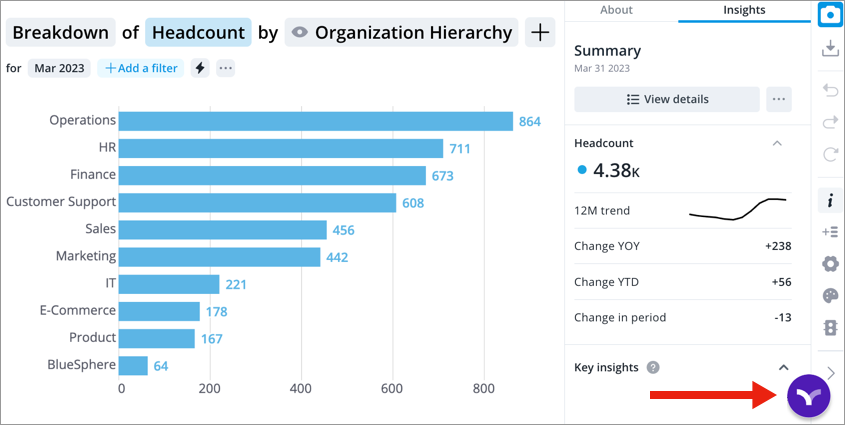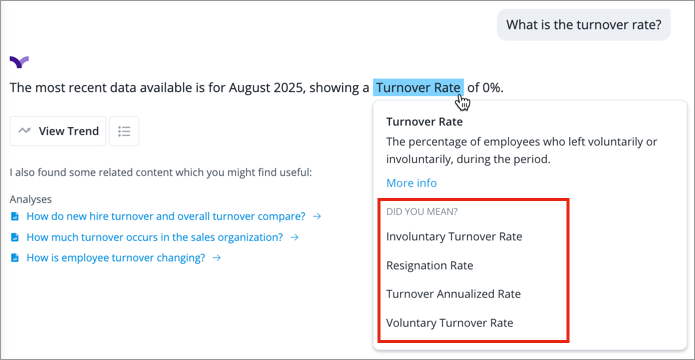Get Started with Vee
Best practices and guidelines on how to ask
Start a conversation with Vee
Who can use this feature?
Users with this permission capability:
-
Vee Core
Not sure if you have this feature or capability? Reach out to your administrator.
To access Vee:
- Click Ask Vee
 on the navigation bar.
on the navigation bar. - Click the Vee icon.

Note:
- This is not available to Embedded Partners.
- Vee will appear when:
- Conducting exploratory analysis in the Explore room or full screen.
- Viewing analyses (in the Home, Guidebooks, or Analyses room).
- Type Vee by Visier in your Microsoft Teams app. For more information, see Vee in Microsoft Teams.
Ask Vee
Use the following workflow as guidance when chatting with Vee.
- Enter a question in plain language or click the Sample questions button
 to explore the types of questions Vee can answer.
to explore the types of questions Vee can answer.
- Review the answer:
- View the visualization that is generated.
- Inspect the response to see what analytic objects were used in the answer. When inspecting, you can try a different metric, tweak added filters, or replace them with something new.
If the wrong object was selected, hover over the highlighted object to see a list of alternatives you can choose from.

- If Vee needs more context to answer your question, it will pose a clarifying question for you to review and proceed. Vee may suggest alternative questions, metrics, or dimensions.
Note: To view generated visualizations in a response, users must have the Vee Visualization permission capability.
-
Ask a follow-up question. Vee retains your current chat history, so you don't need to worry about retyping the whole question from scratch. You can ask multiple questions to delve deeper into a single inquiry.
- Drill down further by entering another question or selecting one of the suggestions. For example: What about last month?
- If the response isn't quite what you are looking for, you can adjust the result by suggesting changes and edits. Vee will refine its response based on the additional information. For example: Group by Organization or I meant Jason K
- Provide feedback to the generated response by clicking the Helpful button
 or Wasn't Helpful button
or Wasn't Helpful button  . When providing feedback on a response that wasn't helpful, be sure to write comments that explain why the generated response wasn’t helpful and what you expected to see.
. When providing feedback on a response that wasn't helpful, be sure to write comments that explain why the generated response wasn’t helpful and what you expected to see. -
To start a new conversation, click the New topic button
 in the upper-right corner of the screen. Vee retains context in a conversation to better understand follow-up questions, maintain continuity, and provide more natural, relevant responses. Start a new conversation with Vee when you switch to a completely new and unrelated topic, if the current thread has become too long, or when you want a clean slate.
in the upper-right corner of the screen. Vee retains context in a conversation to better understand follow-up questions, maintain continuity, and provide more natural, relevant responses. Start a new conversation with Vee when you switch to a completely new and unrelated topic, if the current thread has become too long, or when you want a clean slate.
What can Vee do?
Ask Vee any question about your workforce and it will try to provide an answer based on your organization’s people data. It excels in providing answers about current events and past occurrences. Questions starting with "which," "where," "how," and "who" are typically well-suited for Vee's capabilities.
Vee can:
- Pinpoint potential reasons for fluctuations in metrics, whether they are on the rise or decline.
- Examine aggregate data or provide detailed profiles of individual employees.
- Combine multiple metrics to help you grasp relationships and correlations.
- Suggest additional questions or alternative ways to analyze the data you've requested.
- Demonstrate contextual awareness, allowing you to use multiple questions and delve deeper into a single inquiry. It can handle spelling errors and most language nuances effectively.
When chatting with Vee in the Explore room or full screen, Vee can:
- Update the chart in real time with follow-up questions to gain deeper insights. Common follow-up questions include changing filters and group by's, changing the time context, and adding a comparison metric. For example, you can follow up with:
- Filter by high performer (filter)
- Grouped by age (group by)
- Show in Q2 2022 (time)
- Compared with exit rate (compare)
- Filtered by high performer, grouped by age, in Q2 2022 (combination)
Vee in Explore and full screen uses the displayed chart as context for its responses. For general questions unrelated to a specific chart, use the Vee room.
LLM-generated responses
Note: This feature uses large language models (LLM) hosted in Microsoft Azure to send organizational data and chat history and return LLM-generated responses (narratives and charts). Customer data is not used for training purposes and no prompt submissions are retained. If you're interested, please contact your Customer/Partner Success Manager.
Vee's responses (narratives and charts) are based on your organization’s people data. By default, these responses are generated from a combination of fixed templates and a complex set of rules that analyze the charts Vee creates.
Optionally, Vee can generate responses using a large language model (LLM). With LLM-generated responses, Vee partners with LLMs to help generate a narrative based on your organizational data and chat history. The responses will be more conversational and tailored specifically to the insights in your data. The LLM can highlight key trends, anomalies, and relationships in a more natural, engaging way. The generated responses can provide new ways of explaining the data, providing a fresher perspective with each analysis. For more information, see "Asking a question" in Vee Architecture, Privacy, and Security.
To see the difference, let's look at how Vee answers the same question with these two different options. The first example shows the default response, while the second shows an LLM-generated response.
Default response

LLM-generated response

Conversation summaries
Note: Limited Availability The conversation summary feature (Vee Summarization) is in limited availability. If you're interested, please contact your Customer/Partner Success Manager.
Vee can instantly summarize its responses within your current conversation. To request a conversation summary, click the Summarize button ![]() in the chat. Vee will return a summary of all of its responses within your current conversation thread so you can easily review the key information.
in the chat. Vee will return a summary of all of its responses within your current conversation thread so you can easily review the key information.
Vee uses large language models hosted in Microsoft Azure for the advanced translation of natural language into query language and generating summaries of text. Customer data is not used for training purposes and no prompt submissions are retained. For more information, see Vee Architecture, Privacy, and Security.
Write effective questions
Generative AI models are powerful but may not always produce perfect output. Effective questions can help guide the model to provide more relevant and accurate responses. Vee offers prebuilt questions for your convenience, but if you seek deeper insights, we recommend following these guidelines:
- Be clear and specific: Clearly state the question you want answered. For example, if you want to know who among the top performers is more likely to leave the company, ask Which high performers have the greatest risk of leaving in the next year? instead of Which employees are showing signs of leaving soon?
- Provide context: Additional context or background information can help narrow the response, especially if it refers to a specific topic or scenario.
- Avoid ambiguous questions: If there's room for multiple interpretations, Vee may not provide the answer you want.
- Ask follow-up questions: To get a more detailed response, you can ask follow-up questions. For example, if you receive a general answer, you can follow up with: Please show me that over time or Filtered to managers only.
- Be mindful of ethical considerations: Ensure that your questions are in line with Visier's Acceptable Use Policy and ethical guidelines.
- Review and filter output: Always review the generated output to ensure it meets your requirements. You can filter, edit, or moderate the content as necessary.
- Experiment and iterate: Don't be afraid to experiment with different questions and phrasing. Vee may respond differently to slight variations in questions. Iterate and refine your questions to get the best results.
- Practice and learn: Writing effective questions will take practice. The more you use Vee and experiment with different questions, the better you'll become at getting the desired results.
- Ask one question at a time: If a question contains two parts, split them into separate questions. For example, instead of asking What is my headcount and how is it changing?, begin with What is my headcount? and then ask a follow-up question How is it changing?
Here are some phrases you can use to craft your questions:
|
Phrases |
Examples |
|---|---|
|
Show me |
Show me headcount |
|
Filter for |
Filter for high performers |
|
By |
|
|
Combine with |
Combine with Compensation Ratio |
|
Remove/Exclude |
|
Supported visualizations
The following table shows the visualizations that Vee supports, along with example questions that will generate each specific visualization in a response. Visualizations not listed are currently unsupported.
|
Visual type |
Example question |
|---|---|
|
Breakdown |
What is the headcount by location for May 2024? |
|
Trend |
What is the resignation rate trend for the last 12 months? |
|
Bubble Grid |
What is the resignation rate by location and job function? Note: When grouping by two dimensions, Vee will return the Bubble Grid visual only. |
|
Movement Breakdown |
What was the employee movement for the last month? |
|
Quadrant |
What is the correlation between employee exits and starts by organization this year? |
|
Sourcing Paths |
What is the sourcing path for a maintenance engineer? |
|
Career Paths |
What is a possible career path for Olivia Ruiz? |
|
Collaboration Circle |
Who has Augustine Samir Stout's collaborated with? |
|
Drivers |
What are the drivers of the resignation rate? |
|
Detailed View |
List of my direct reports |
|
Metric Value |
What is the total headcount? |
|
History |
Who is Augustine Samir Stout? |
Limitations
- If a question cannot be answered from your organization’s people data, you will need to load that data before Vee can answer your question.
- If a question is asked that has no clear relationship to what Visier could answer, we rely on the large language model to provide the translation. That translation may not always be accurate but will still return a reasonable result.
Example:
If you ask the question: How many managers do I have in each department? and your organization does not have a dimension called Department, the closest match will be used. In this example, the closest match is Organization Hierarchy or Cost Center Hierarchy so you may receive a response that uses the Manager Count metric or Manager Ratio metric grouped by Organization Hierarchy or Cost Center Hierarchy. If the answer is not what you expected, you can ask Vee to use another metric or dimension or tune Vee to reply with the dimension you were intending for. For more information, see Prompt Tuning Vee.
- Custom groups are not supported in Vee due to potential naming conflicts with other objects.
- If a default context is set, Vee will automatically include it in its responses. The default context cannot be removed through Vee.
